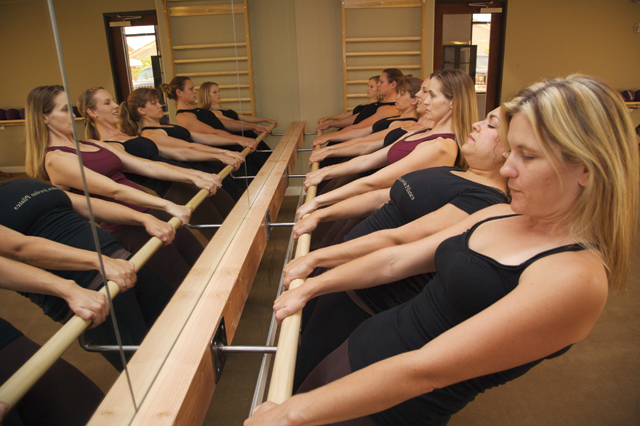 The ballet barre fitness craze finally has hit the Valley after having massive success over the past decade in areas like New York and California.
The ballet barre fitness craze finally has hit the Valley after having massive success over the past decade in areas like New York and California.
So, what is the deal with this method, and why has it become so popular?
Ballet Barre Fitness History
The ballet barre class structure actually started about 60 years ago by a woman named Lotte Berk. Lotte was a German-born dancer, who was forced to retire from her dancing career due to the injuries her joints and spine had taken over the years, from her high-impact dance training.
Lotte didn’t want to lose the fantastic physique that her years of dance training had given her, despite the injuries that came with it. So, Lotte worked with her physical therapist to combine proper alignment and orthopedic stretching techniques with ballet-inspired movements that didn’t involve any impact on the joints or spine.
Lotte’s fitness method became very popular in London. Eventually, she was convinced to open studios in New York City. The following continued to grow exponentially. Since her death in 1994, the method has branched out under different namesakes. Now, the ballet barre method can be found in almost every state, including Physique 57, in New York; The Bar Method, in San Francisco and Los Angeles; and Karve Studio, in Arizona and Utah.
How does it work?
The exercise technique creates a uniquely lean, firm and sculpted body by combining the multiple body-shaping principles of isometrics (small, controlled movements, which keep the muscle working in its maximal calorie-burning range), the body-elongating practice of dance conditioning, the science of physical therapy, and the intense pace of interval training. These all are combined in a progressive exercise format, which quickly and safely reshapes and elongates muscles. The results are the long, lean lines of a dancer:
-
Firm, elongated muscles
-
Reduced body fat
-
Improved posture
-
Long, narrow thighs
-
A lifted seat and defined hamstrings
-
Strong, flat abdominals
-
Increased stamina and energy
The bulkier muscle fibers of the body (which many women are afraid of developing) react to lifting heavier weights, doing less repetition, and adding more rest in between each set. In ballet barre fitness methods, like Karve, isometric training (using very light weight and high repetition on each area of the body) of the arms, waistline, hips and thighs, as well as the seat area, allows the longer, leaner muscle fibers to develop. This method of isometric training is just as intense, if not more challenging, than lifting heavy weights in a traditional weight-training program. After each body part is worked to a fatigued state, the muscles are actively stretched, using Pilates, yoga, and orthopedic-inspired positions to keep the muscles supple.
These controlled movements are very focused, effective and safe because the body and mind are constantly working throughout class. If you lose mental engagement, your results will not be as noticeable. Proper alignment is the primary focus, no matter what body part is being worked. In addition, every class has a variety of positions, which are linked in an interval-based format in order to keep caloric burn at its highest, and impact on the joints at a minimum. Although the class structure is sequenced specifically to define the body and burn fat, it is never the same workout every time.
Overall, the ballet barre fitness technique is not a dance class, nor does it really resemble ballet at all. Clients in class aren’t expected to do the splits, nor are there any dance moves or complicated choreography to intimidate clients. Ballet training inspires the positions and moves done at the ballet barre. However, the aspects of alignment, safety and focus create a well-balanced fitness format beneficial for all fitness levels, even for those who experience difficulty attending traditional group fitness classes.
The secret to any fitness regime is to do something you enjoy, and keep your routine from getting stale. This method provides just that and all of the components (strengthening, stretching and cardiovascular) you need to develop a strong healthy physique.
For more information, call (480) 840-1860.

